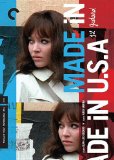| Reviews & Columns |
|
Reviews DVD TV on DVD Blu-ray 4K UHD International DVDs In Theaters Reviews by Studio Video Games Features Collector Series DVDs Easter Egg Database Interviews DVD Talk Radio Feature Articles Columns Anime Talk DVD Savant Horror DVDs The M.O.D. Squad Art House HD Talk Silent DVD
|
DVD Talk Forum |
|
|
| Resources |
|
DVD Price Search Customer Service #'s RCE Info Links |
|
Columns
|
|
|
Made in U.S.A. - Criterion Collection
THE MOVIE:
"I understood very quickly. This affair had to remain murky for everyone, and my life was on the line."
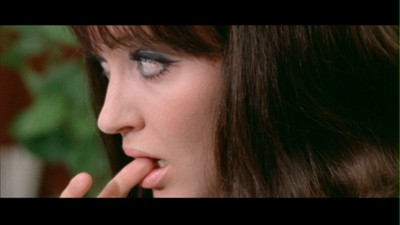
Donald Westlake's Parker is the kind of guy who can never get a break. A bad dude who cleans many a house in all corners of the underworld, he starred in twenty-three novels, but you'd almost never know he had a movie career, too. Maybe it's some strange karma that, since Westlake wrote this crook's stories under the nom de plume Richard Stark, Parker's most famous cinema adaptations have changed his name to something else. The John Boorman flick Point Blank has Lee Marvin playing Walker, whereas Brian Helgeland's Payback cast Mel Gibson as Porter. Never mind that they were both based on the same novel, The Hunter, which was the start of the series. By all reports, poor Parker is faring better now that he's branching out into comic books. Darwyn Cooke's adaptation of The Hunter is due to be released any day now, and by all advance reports, it's brilliant. (Read a preview at the publisher's website.)
In 1966, Jean-Luc Godard adapted a different novel, turning The Jugger into Made in U.S.A. and Parker into a woman in the process. Such are the things you can get away with when you don't bother to get the author's permission to turn his novel into a movie. Made in U.S.A. was reportedly barred from lighting up screens on this side of the Atlantic thanks to successful litigation by Westlake. I can't say I blame him, and from the looks of things, Made in U.S.A. is so far away from its alleged source material, I am not sure why Godard didn't just pretend he came up with it on his own.
In The Jugger, Parker travels to small-town Nebraska to silence an old heistman who knows too much about his past, only to find someone else has done the silencing for him. The question is, how much had the geriatric crook talked before the end came? In Made in U.S.A., Parker's stand-in is Paula Nelson, played by Anna Karina. She is visiting Atlantic-Cité to dig up the dirt on why her ex-fiancé, Richard P... (voiced by Godard on tape, but never actually seen) was put in that selfsame dirt. Paula is some kind of sexy secret agent, a smuggler perhaps, a sort of veteran of various wars. Richard was a communist, and though everyone involved with the murder and the cover-up act like gangsters, it's all political. It's the 1960s, and when looking through Godard's dark sunglasses, politics are the new criminal activity.
As with most Godard films, "plot" is of little importance in Made in U.S.A.. Paula has come to town, she's approached by a little man named Typhus (Ernest Menzer) who claims to have worked with Richard, she beats him with a shoe, she meets his novelist nephew (Yves Afonso) and his Japanese girlfriend (Kyoko Kosaka), hangs out in a café, hears an a cappella performance of "As Tears Go By" by Marianne Faithfull, eventually gets around to asking some questions. It's all rather loose and off-the-cuff, the driving force of the story coming back around almost like an afterthought. There are plenty of messages even when there is no story--advertising is overtaking everything, war is immoral, the times they are a-changin'--but as usual, they are so entwined within the medium, sorting it all out can seem both daunting and silly. The standard modus operandi of any private detective movie is that the more the shamus explains, the more obscured the facts become; Made in U.S.A. subverts this by never bothering to explain, it's only obfuscation. There is a little bit of voiceover, but it has a meta hue. Sometimes, it's not voiceover at all, but Paula or Widmark (Laszlo Szabo) turning to the camera and describing their conversation rather than having it. Likewise, a tape recording of Richard takes over the role of "narrator" once it surfaces, and in the final switch, Paula makes her own tape.
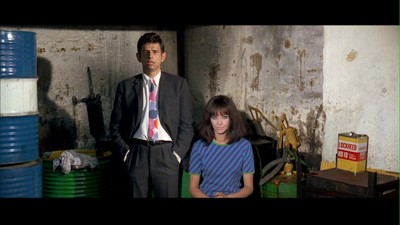
Made in U.S.A. begins with a dedication to Nicholas Ray and Samuel Fuller, and it's the Hollywood tradition that they represent that is more important to Godard than the Westlake novel (and also likely where the title comes from). A Walt Disney film starring Humphrey Bogart is how Paula self-reflexively describes it, suggesting it's Bogie's presence that makes it a meaningful gangster picture. The gangsters played by Jean-Pierre Leaud and Laszlo Szabo are named for the director Donald Siegel and the great film noir villain, Richard Widmark. Jean-Claude Bouillon's police inspector takes his surname from Robert Aldrich. Most of the streets mentioned are also names of famous writers and directors--Ben Hecht, Otto Preminger, etc.* Daisy Kenyon and Ruby Gentry are women paged at a spa. Leaud's tic of shaking up a puzzle as he walks is like an overly complicated version of George Raft flipping a coin in Hawks' Scarface (which Raft would parody himself a year later in Casino Royale). In this film, perhaps more than any other, Godard is placing himself in the American cinematic milieu, letting it enfold him, and then kicking the crap out of it on his way out.
Given the political bend of the film, in addition to the American criminal mythology, American politics are also going to come up. Though Godard is none too thrilled with the conservative leanings of the French government, the war in Vietnam and the new rule of Richard Nixon has already taken the mark at the center of the world stage. The director's weariness over war is transferred to two hoods who are tired of the fighting, tired of chasing Paula. They are played by Sylvain Godet and Jean-Pierre Biesse, who are christened Robert McNamara and Richard Nixon, respectively. Maintaining a course of human misery requires a certain fortitude. Leaud's Siegel can't take it, only Widmark and Paula have the intestinal mettle to see this thing through.
Anna Karina wouldn't make a very convincing tough guy, and she doesn't really try for it. Her main weapons are her beautiful, smoky eyes, which are always watching, and her killer mod wardrobe, which is regularly commented on, its practical use being to distract. Though she seems indifferent at times, that is really unflappable persistence. At one point, she is clocked on the head and wakes up in Widmark's auto garage, and she's not really affected. She gets up and begins asking her questions right where she left off. Godard dresses her in bright colors, and he and his regular cinematographer, Raoul Coutard, give the rest of Atlantic-Cité a matching neon glare. Billboards and posters are everywhere, advertising something or other, but they are also starting to crack, peel, and fade. They are interchangeable props, often being changed and/or dumped as Paula watches. American values based on commercialism don't take long to go out of date.
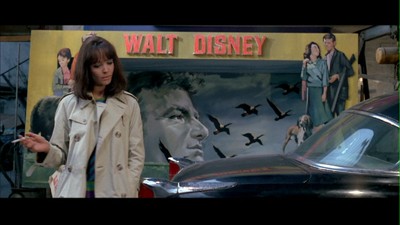
Perhaps this is what Paula has really come to kill off, the creeping influence of American thinking. There must have been a bitter irony for Godard that the country that gave him his beloved art was seeking to mold the world to its capitalist ways through that same art. (I am sure the global market has made that all the worse for him; I can't imagine him enjoying a Starbucks and a Big Mac.) If we choose to see Paula as a stand-in for Godard rather than one for Westlake's anti-hero, then once she has avenged Richard, there is no choice but to retreat from this strange American amalgam to something more European. Having political-minded journalist and filmmaker Philippe Labro--who himself studied and traveled in the United States before returning to France and serving in the military in the Algerian war, a path that likely inspired much of Paula's backstory--pick her up at the border in a car with the word Europe painted on the side* is the kind of deliberate agitprop symbol that was becoming increasingly attractive to Godard at the time. The film ends with them in the car discussing how the two-way thinking of right and left has become outmoded. Yet, typical of a movie that has gone out of its way to avoid clear answers, so too are no solutions offered before cutting to black. Paula asks, "How then?" and the only reply: FIN.
"About Richard...I think it had to do with revenge. But this whole business of yours is not very clear."
So, Parker may not get his due in Made in U.S.A., but maybe he couldn't have handled it, anyway. This world is not black-and-white enough for most gangsters. There is no putting it right, one must be comfortable with the imbalance remaining. Crime pictures often end with realizations that all this running around robbing and killing is pointless, but there are still clear roles being played, and the underworld remains self-contained. In Godard's version, the pointlessness has spread, and it requires a disaffected Anna Karina and her deadly shoes to make her way through it. The usual toughs are too tired and too overwhelmed to get out.
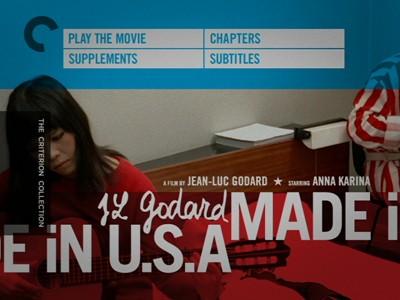
* This reminds me of current practices in the Batman comics where they name Gotham streets after famous Bat writers and artists.
** The car logo is actually for Europe 1, the radio service Labro works for in real life.
THE DVD
Video:
Made in U.S.A. debuts on DVD in North America with a fantastic 2.35:1 anamorphic transfer. Criterion has created a beautiful disc, vibrant and colorful, with a clean image and no compression problems. This is a DVD to be proud of, they've done an amazing job.
Sound:
The mono mix of the French audio, naturally, doesn't have any tricky speaker interplay, but it still sounds clean and fresh, creating nice levels that conform to Godard's typically clever soundscape.
The new English subtitles are cleanly written and easy to read.
Extras:
The Made in U.S.A. - Criterion Collection DVD comes in a clear plastic case with a double-sided cover. The interior booklet has photos, a chapter listing, cast and crew credits, and an essay on the film by J. Hoberman.
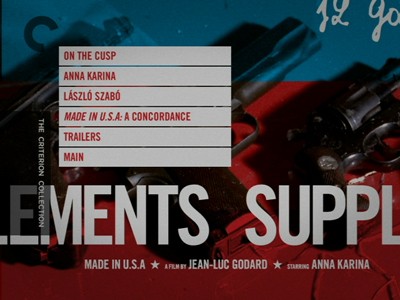
There are a handful of extras on the DVD, all of which contribute to a greater understanding of the film. The best are two new video programs aimed at decoding the meaning of the picture. "On the Cusp" (26 minutes, 25 seconds) is a featurette with Godard biographers Richard Brody and Colin MacCabe going over the political and personal concerns that went into the making of Made in U.S.A. and 2 or 3 Things I Know About Her, which were shot back to back. In addition to how these things influenced the subject matter, they also look at how they effected the style of the pictures. There is some crossover with the video essay "Made in U.S.A.: A Concordance" (17:25), which decodes the specific references to political figures, history, pop culture, and whatever else struck Godard's fancy. The layering of information is astounding.
Two of the films stars sit down to talk about the film. A 2002 Anna Karina interview (10 mins.), excerpts from which appear on other Criterion releases from Godard's catalogue, and a 2009 chat with Laszlo Szabo cover this specific film with JLG, as well as their overall relationships with him.
Finally, there are two trailers on the disc: the 1962 original and the recent re-release trailer. They are virtually the same, it's just the new one adds new titles on the front and back. It's a brilliant tease, a clever silent "mini film" from the master.
FINAL THOUGHTS:
Made in U.S.A. was part of the filmic shift into the final phase of Jean-Luc Godard's 1960s oeuvre. A pulpy dismantling of American crime fiction, it substitutes battles over cash and reputations with battles over political ideals. Referencing Hollywood films and filmmakers amidst more serious historical minutia, Godard runs wild with a bright and colorful look that is at once vibrant and decaying. Lingering shots of Anna Karina, non-sequiturs galore, a little gunplay, a fetish for neon--it's a heady mix that stays light on its feet. This Criterion disc is a nice package with great extras, and though Donald Westlake may not have liked what Godard had done with his novel, we can enjoy Made in U.S.A. like never before. Highly Recommended.
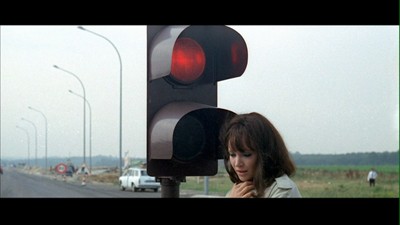
Jamie S. Rich is a novelist and comic book writer. He is best known for his collaborations with Joelle Jones, including the hardboiled crime comic book You Have Killed Me, the challenging romance 12 Reasons Why I Love Her, and the 2007 prose novel Have You Seen the Horizon Lately?, for which Jones did the cover. All three were published by Oni Press. His most recent projects include the futuristic romance A Boy and a Girl with Natalie Nourigat; Archer Coe and the Thousand Natural Shocks, a loopy crime tale drawn by Dan Christensen; and the horror miniseries Madame Frankenstein, a collaboration with Megan Levens. Follow Rich's blog at Confessions123.com.
|
| Popular Reviews |
| Sponsored Links |
|
|
| Sponsored Links |
|
|
| Release List | Reviews | Shop | Newsletter | Forum | DVD Giveaways | Blu-Ray | Advertise |
|
Copyright 2024 DVDTalk.com All Rights Reserved. Legal Info, Privacy Policy, Terms of Use,
Manage Preferences,
Your Privacy Choices | |||||||









